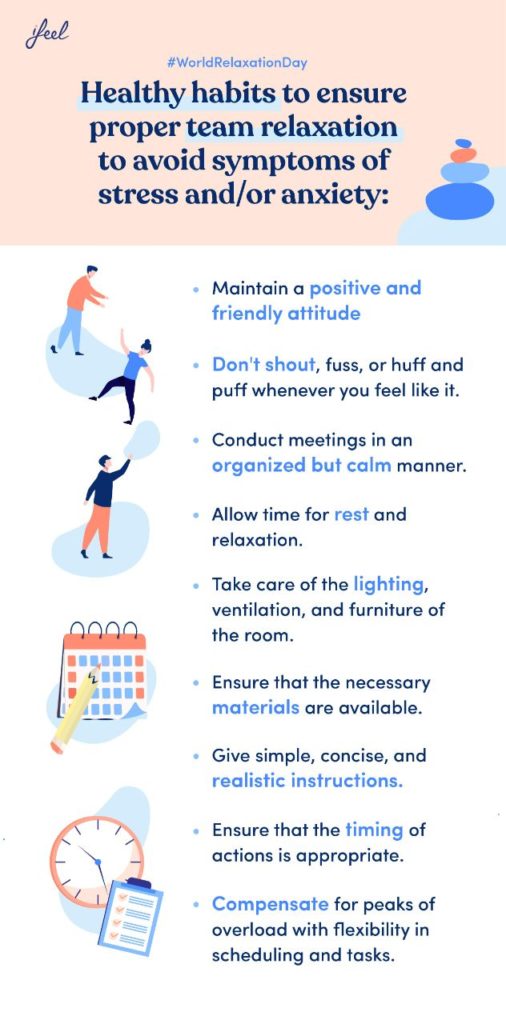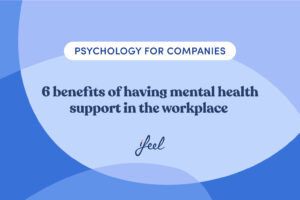Content
ToggleHow to support mental health at work
Although some organizations are still reluctant to identify this, many HR managers are aware of the importance of supporting employees’ mental well-being at work as a key technique to improve the organization’s overall performance and boost its internal and external reputation.
To achieve this through this methodology, it is necessary that staff, especially those with more decision-making power, reflect on the current content their workplace culture represents. They must also consider to what extent this culture is reflected in the well-being of employees at work, improving or boycotting it.
Such reflection must be constant, given that the circumstances in which any company carries out its mission are in continuous transformation, varying the extent to which they are beneficial or hinder the company’s success.
The organization must have a sufficiently flexible and ambitious capacity to carry out a strategy to improve its employees’ well-being at work and have the appropriate professional support to implement it. One support scheme that is already generating several significant success stories is the emotional well-being program for companies designed by ifeel‘s team of psychologists.

What’s the purpose of well-being at work?
Providing well-being at work is not (just) a favor that the company does to its employees to make them feel at ease for the sake of it. Far from it, well-being at work is an essential requirement to increase employee motivation and commitment to the company, with a significant positive impact on labor productivity.
It has been proven that employee performance tends to improve if they perceive that they are taken into account by the company, that the company does not seriously interfere with their quality of life, and that the monetary or emotional retribution they receive is in line with their profile.
What employees are seeking in a company is not so much that it makes them happy but that it provides them with enough well-being at work to make them feel part of it and not want to leave.
Join the global leading solution in mental well-being
Well-being at work plan
To achieve the goal of labor productivity improvement through the support of workplace well-being for employees, the company should have a strategic plan that allows it to succeed in a controlled and not improvised manner.
How to create a well-being at work plan
- Taking into account different sources of information from various areas across the entire team.
- Involving staff in the improvement of their well-being at work, without using them simply to “extract” data that is not reflected in any area of their work.
- Integrating concrete and appropriately targeted improvement measures for the company’s current employees
- Assuming the risk of changing and reviewing workplace culture or making it effective through actions that allow achieving the objectives that the company needs to meet to keep its values alive.
- Following a strategic process for delivering the workplace well-being development plan: you should clarify not only what methodology you will apply, but also over what period and how and when the findings will be communicated to staff.
How to improve employees’ well-being at work
Set a starting point
Measure the baseline of well-being at work as seen by employees through structured, semi-structured, and open-ended tools (questionnaires and interviews) that include a needs assessment and proposals for improvement. When, after an appropriate period (e.g., one year), the level of well-being at work is measured again, both values will be compared to determine the degree of effectiveness of the measures implemented.
Take staff rotation into account
Measure the staff rotation rate, bearing in mind that it should not be excessively high, as this would mean a company is incapable of retaining most of the workers it hires, nor excessively low or equal to zero, which would indicate a company is not very dynamic and incapable of growing or recruiting new talent.
Make the most of employee assessment
Conduct a detailed study of the data collected from the exit interviews conducted during the last year, as well as from the performance reviews or from a selection of them that includes every department of the company.
Set goals that indicate improvement in well-being at work
Set concrete, measurable, significant, and time-bound targets for the workplace well-being rate. For example:
-Achieve that at least 70% of the workforce rate their employee experience as a 7 or higher within one year.
-To achieve that, the next time we measure the work climate of the team, the average increases by at least 3 points.
-Maintain the employee turnover rate within X values for the next 12 months.

Workplace well-being programs: what do you need to know?
Designing well-being programs in companies is a useful methodology to respond to a legal obligation that all companies have: to identify, evaluate and prevent psychosocial risks to which their employees may be exposed.
In this article, we will explain the fundamental elements you must consider to draw up a suitable workplace well-being program for your company.
What are company well-being programs?
Company well-being programs are basically strategies designed by HR management departments. They are aimed at fostering a new type of productivity that is achieved not at the expense of workers’ physical and psychological well-being, but by using this well-being as an essential tool for progress.
Therefore, well-being programs in companies seek the growth of the company while taking care of the growth of the people who are part of it.
What are company well-being plans like?
Before making the first concrete and company-specific decisions about the best workplace well-being plan for us, we need to take into account the main characteristics of this type of strategy.
Knowing what a good workplace well-being plan looks like is the best starting point for implementing it.
| Characteristic | Description | |
| 1 | Process | A well-being plan is not an isolated event, nor a sequence of erratic or improvised actions. On the contrary, company well-being solutions have, by definition, a strategic nature: they start from a reflection and understanding of the characteristics of the company and the needs of its employees to subsequently make decisions within a previously established timeframe. Well-being solutions in companies follow a series of steps from point A to point B, with point A being understood as the start-up of the plan and point B as its full implementation. |
| 2 | Continuous | The implementation of well-being plans in companies continues as they become essential to business policy, corporate culture, and the working methodology followed in the company’s various departments. |
| 3 | Dynamic | Well-being plans in companies are subject to a permanent review and evaluation of their efficiency. They are living processes that must be adapted to the evolution of the needs and characteristics of employees. Well-being plans in companies can and should change in order to adapt to new situations and new demands from employees.to |
| 4 | Places the team at the center | All well-being plans in companies must have the employee at their core if they are to be successful. The aim is for the company to grow, but they start from the premise that it cannot do so if it overlooks the well-being of its employees. That is why you have to focus on them realistically and in a way that is adapted to their particular needs. Not all workers have the same needs at any given point in their employment life cycle, nor do they all have the same aspirations. Therefore, not all rewards or benefits put in place by the company are equally motivating for everyone. Factors such as age, seniority in the company, the presence or not of a family or their level of responsibility in the team can greatly influence whether or not they benefit from an organisation’s well-being plans. |
What are company well-being programs like?
Before making the first concrete decisions adapted to our company about the best well-being at work program for us, we must take into account the main characteristics of this type of strategy.
Knowing what a good well-being at work program looks like is the best starting point for implementing it.
They are a process
Regardless of its content, a program is not an isolated event nor a sequence of erratic or improvised actions as we go along. On the contrary, well-being plans in companies have, by definition, a strategic nature: they start from a reflection and understanding of the characteristics of the company and the needs of its employees and then make decisions within a previously established time frame.
Therefore, well-being plans in companies follow a series of steps from point A to point B, with point A being understood as its implementation and point B as its full implementation.
They are a continuous
Once its full implementation is established, the process of applying well-being programs in companies continues, becoming an essential part of business policy, corporate culture, and the work methodology followed in the company’s various departments.
They are dynamic
Well-being programs in companies are subject to a permanent review and evaluation of their efficiency. They are live processes since the company is also alive and has to adapt its well-being programs to the evolution of employees’ needs and characteristics. Well-being programs in companies can and must change in order to adapt to new situations and new employee demands.
Their teams are their priority
All well-being programs in companies must have the employee at their core if they are to be successful. It would make no sense to design them any other way. Their objective is for the company to grow, but they start from the premise that it cannot do so if it overlooks the well-being of its employees. That is why you must focus your attention on them in a realistic way, adapted to their specific needs.
Not all employees have the same needs at any given point in their life cycle as employees, nor do they all have the same aspirations. Therefore, not all rewards or benefits put in place by the company are equally motivating for everyone. Factors such as age, seniority in the company, the presence or not of family, or their level of responsibility in the team can greatly influence whether or not they benefit from the well-being programs implemented in an organization.

Why implement a well-being program?
The day-to-day experience of many companies indicates that corporate well-being programs have enormous benefits for both the results and employees’ day-to-day experience.
It is not surprising that both areas are the main indicators of the benefits of well-being programs in companies: it is important to understand that the more comfortable a company is to work in, the better the results of its employees’ work. This, in turn, positively reinforces the established work methodology and encourages them to continue working this way, setting a beneficial corporate dynamic at all levels in motion.
What are the benefits of well-being programs in a company?
As implied, it is worthwhile for all companies wishing to improve their productivity to do so by safeguarding the well-being of their employees – and employing that well-being as a driver of performance. To this end, they should consider the following benefits of corporate well-being programs:
Improve employee motivation
An employee who receives benefits from the company that are truly useful and adapted to their needs will feel rewarded for their work and taken into account by the company. Therefore, they will tend to be more interested in achieving good results.
Improve the company’s working environment
Many happy employees will generate an overall positive, calm work atmosphere, oriented towards cooperative task completion rather than getting worn out in conflicts and complaints about the asymmetry between their effort and the care they receive from the organization.
Improve the physical and psychological health of employees
High motivation is not just about “wanting to work”; a favorable work environment is not just about “getting along with colleagues”. Having a proper well-being program at work means that we can organize our lives inside and outside of work in a healthy, positive, and satisfying way, which is good for the way we work, but above all, it is good for our health.
3 key elements of corporate well-being
The term corporate well-being is frequently referred to as the latest trend in the occupational well-being field in terms of the different techniques companies use to take care of their employees.
It is also often said it is an evolution -an improved version- of the traditional idea of corporate well-being. The latter refers mainly to the physical well-being of employees, through physical activity, nutrition, physiological activation, or, for example, sleep routines.
However, the concept of corporate well-being is establishing itself as a more complete and appropriate alternative to the organizations’ current situation. Of course, organizations have always had to adapt to the different circumstances, but the emergence of the Covid-19 pandemic, along with all its consequences, has accelerated the changes in this direction.
As a result, the different physical and psychological well-being policies implemented by companies have become more complex and demanding, but also more aligned with employee needs. Needs, expectations, and demands that, of course, go beyond the traditional models of flexible remuneration or emotional pay.
Three aspects of corporate well-being
Differentiate between productivity and performance
It is not designed as a gift to employees to compensate them for their efforts. In reality, it aims to strengthen people’s well-being as a tool for sustainable productivity improvement, rather than improving productivity in any way and therefore at the expense of people’s well-being.
It is holistic, complete, and inclusive
It takes into account a concept of complete well-being, both physical and psychological, more in line with the real definition of health. It adapts to the characteristics of staff members and considers their needs when defining the implemented measures.
It is organized and purposeful
Corporate well-being is not a random consequence of giving some importance to employee’s physical and psychological health. On the contrary, it responds to an explicit plan, which starts with the identification of needs, goes through the making and execution of decisions aimed at taking care of the employee’s health, sets realistic, concrete, measurable, and scheduled objectives, and has a concrete methodology for the evaluation and communication of results.
Companies’ employee well-being policy will be based on corporate well-being or it simply won’t be there. That is why ifeel has developed an emotional well-being program for companies designed by its team of leading psychologists. This collaborative program aims to help companies place the psychological health care of their employees at the heart of their company culture as a basic tool to boost sustainable productivity.
To do so, the program supports managers in equipping them with the necessary skills to take comprehensive and systematic care of employees’ health.
In addition, HR managers can receive personalized, data-driven advice on how to improve the work environment, preventing psychosocial factors that can put it at risk and jeopardize employee experience.
In addition, ifeel‘s emotional well-being program for companies offers employees a mental health care service structured at different levels depending on what they need at any given time. Employees can access a variety of mental health care tools via ifeel‘s app. On a second level, they can receive emotional support through a chat with one of our platform’s registered psychologists. If continuous help is needed, they only have to access the third level of the program: online psychological therapy with a psychologist specialized in cases like theirs.
Get in touch today and request more information on how our emotional well-being program for companies can help you take care of corporate well-being in your organization.
Why is emotional well-being important in the workplace?
The importance of taking care of emotional well-being in a company shouldn’t just be a priority for big corporations with a large workforce and a widely developed workplace culture.
Small and medium-sized companies also own workplace culture, even if they aren’t fully aware of it or are still growing. However, they are also made up of humans. No matter how small the team is, a large part of their performance depends on their emotional well-being.
To take care of it shouldn’t be a question of improvisation or take for granted that it is already being done. On the contrary, it can be done through special emotional well-being programs for companies provided by professional psychologists, such as the one ifeel offers to its partners.
Why is emotional well-being important in small and medium-scale companies?
Each phase of a company’s life cycle has its psychosocial challenges. This is applied to both multinational organizations which have been running for hundreds of years and startups whose staff doesn’t go over ten people.
To be born, build a brand, surpass obstacles, overcome funding rounds, expand… All these are different challenges that appear as a company grows, and challenges its members to adapt to changing demands.
The fact that a company is consolidated doesn’t mean it doesn’t have its challenges. No company, no matter how powerful, has an assured future. Bigger companies have many financial resources but also a complex set of interests that are sometimes hard to coordinate. They also count on being a known brand and having a reputation to maintain. Above all, they are sustained by an army of workers whose performance can decline at any point due to different factors, therefore it is important to focus on emotional well-being in a company’s workplace.
Nevertheless, stress, anxiety, fear, interpersonal conflicts, frustration, or mistakes made when leading a team are not exclusive to a certain type of organization: they are there from the beginning, middle, and end, it doesn’t matter how much a company grows.
This is why it seems so efficient to rely on a personalized counseling program for human resources managers and have a strategy to prevent mental health problems from its first phases and take care of the company’s emotional well-being program.
Thanks to the emotional well-being program for companies designed by ifeel, companies can provide support in an orderly manner based on their workers’ mental health data.
Small and medium-sized companies know the value of managing money effectively. Evidence suggests it will be more cost-effective for a company to face mental health deterioration within their team when it first begins.
Understand the importance of caring for mental health in the company
Why is emotional well-being important in the workplace? The stress of starting, mistakes made by beginners, the increase in tasks due to fewer people, the breakdown between happiness and frustrations, take over small and medium-sized companies. When they don’t have a strategy that focuses on their emotional well-being, based on data and accompanied by professional psychologists, the workplace environment suffers more, and this harms their productivity.
Small and medium-sized companies also have fewer resources. However, they can execute flexible and agile processes with ease, compared to the massive movement that would take place in a large corporation.
Therefore, the challenges faced by smaller companies are compensated with human brilliance when there is a lack of resources available to them. Of course, knowing that the brilliance doesn’t come from one day to another: it comes from long-term effort and improving day by day.
To ensure the human aspects outweigh the material ones, companies should implement care for the emotional well-being of their staff. So, what’s the right approach? This should not be part of a superficial workplace culture but a specific medium that implicates people who are part of the company’s development and grow with it. And of course, understanding that this is the most powerful tool to improve workplace productivity.
As we explained, achieving it should be part of an overall good intention from those higher up, but these good intentions are not always enough. It is necessary to embed them in decisions and structure a strategy focusing on psychological well-being from the beginning. As of then, other complex processes will emerge.
Grow slowly, care quickly
Newcomers to the entrepreneurial ecosystem have a mission that not all companies can fulfill efficiently and tests the emotional well-being of their staff.
Smaller companies must adjust their desire (and need) to grow quickly with a demand that pushes them to grow at a slower pace. That reality will often get in the way of the company’s path.
The life of a startup is based on imagination more than reality. These companies don’t have a past, they don’t have an ongoing policy based on how everything has “always been done” like older companies. That being said, they face an uncertain future, which can create anxiety amongst their workforce, which they should discuss openly and make clear in their mission.
Going through the so-called “valley of death” within a new company and seeing it go through favorable evolutionary stages has something of an “artistic participation”. It’s somewhat similar to watching a piece of marble emerge into a statue, a sketch of a house turn into a building, and a piece of cloth into a dress.
It is important to emphasize that we are discussing participation, not contemplation. What’s the difference? To contemplate is to revel in poetry whilst implicating yourself actively in the development of a company, is not only poetic but also creates a psychological strain on staff.
4 ways to strengthen mental well-being at work
Mental well-being at work is an essential factor that contributes to an organization’s overall performance and success. Whatever we do, the “office” is a place where our interior well-being can be affected but also where we have an opportunity to take care of ourselves and those who work alongside us.
Every work environment is different, just like every person is. Therefore, when evaluating what we can do to take care of our mental well-being at work, we can see that there are infinite factors that could strengthen, or be detrimental, to our psychological well-being. Why? Because not everyone is affected by the same things, nor do we have the same needs.
If you want to take care of your employees’ mental health, don’t over-complicate things and focus on the basics: space, time, conditions, and relationships.
Even so, we shouldn’t get frustrated by not knowing how to agree on a situation that suits everyone. We can’t always overthink that something will slip our minds because there are so many factors that affect employees’ mental well-being at work that it is impossible to support it in just one objective way.
How can you improve your mental well-being at work?
A lot of the time we don’t know where to even begin, whether we are the employees, managers, or HR managers. In these situations, a good starting point to gauge our company’s general mental health is to go back to basics. Consider a few things that, indisputably, need to be preserved to improve mental well-being at work, or the very least, not destroy it.
In this article, we will discuss four ways to strengthen mental well-being at work. It includes general guidelines which you can later adapt to suit your individual needs as an employee and, of course, that it is financially viable in your workplace. Simply take these as some ideas as a starting point. Make the most of seeing what other elements you could add to your list to improve your level of well-being or that of those who you work alongside.
Physical space and psychological well-being
Start by checking that the space is adequate for the task at hand and it is as pleasant as possible for the people who use it. Remember, miracles do not exist and the factory, the office, or the cafeteria are what they are. However, remember what does exist is how we manage the tidiness, lighting, temperature, a few basic materials, or a consistent distribution of furniture.
Physical space has a great influence on how well or how badly we might be feeling, independently of the task we are undertaking. It doesn’t matter if we are junior employees or if we are managers, we must always try and make sure that the material conditions we are working in are appropriate, pleasant and don’t get in the way. As long as people have a comfortable chair and a big enough table, there is good lighting, it is neither too hot nor too cold, no strange noises or junk in the way and, most importantly, that people are not crowded together on top of each other. When building a house, we must start with the foundations.
Proper time management
Time management is crucial for our interior world to work and so we can work properly. We can evaluate this in two ways. The first consists of to what degree an employee has sufficient and appropriate time to carry out their task or duties.
From this point of view, if they don’t have enough time it is going to be frustrating, stressful, and feel never-ending because the demands are meant to be obtainable. The employee will live with a permanent feeling of insecurity due to the possible errors made if they are in a rush.
On the contrary, if there is an excess of free time, the consequence will be to use it in a disorganized way as they can get distracted. Moreover, the employee will get bored and feel that they have to pretend to be working hard, which is exhausting. This can also lead their manager to accuse the employee of not being productive during their workday when in reality, it isn’t their fault that there is no work to do. This could lead to hierarchical relationships becoming damaged.
The alternative way of observing time management does not depend on the company but the responsibility of the individual. Every person must evaluate the best way to distribute their time based on the completion of the tasks ahead. To do this successfully, one must consider the different levels of importance for each task and find the best way to complete them. This means one must develop their ability to be responsible, efficient, and know how to organize oneself. Talent is great, but just by being organized can we make the most of the time that we are being paid for.
Taking care of relationships between employees
If there is anything that can either make or break the subjective well-being of a person it is the relationships with their peers in the work environment. In other words, the quality of interactions and emotional ties with their direct colleagues.
We all know that a job could be the worst in the world but if we do it with wonderful people at our side, it becomes tolerable, even likable. On the other hand, we could be indifferent with a job but if we are surrounded by people with who we have absolutely no connection or that don’t treat us well, it could turn into an unpleasant environment.
Colleagues’ don’t have to be your friends. The most important thing is that we are clear, friends or not, we can appreciate each other and build cooperative relationships, affinity, and trust. This will improve everyone’s mood, as well as the general level of motivation. You guessed it! If we are happy and have a good level of mental well-being at work, the quality of the task we are completing will be better.
Relationships between different hierarchical levels
Interpersonal relationships in the workplace are not only made between counterparts but also direct colleagues. They are also made with their bosses and, if they have them, with their more junior staff.
Interpersonal relationships in the workplace are not only made between counterparts, but also direct colleagues. They are also made with their managers and, if they have them, with their junior staff.
Relationships between distinct levels of the company hierarchy have their quirks compared to those we create with colleagues at the same level. However, both have something in common. We have to carefully take care of them because this is important to work well and is important for the psychological health of all. To do this, we must find the ability to handle the authority associated with our roles without over or under-stepping the mark.
Sometimes, as employees, we see our managers as unknown, unreachable, or authoritarian, and this doesn’t help us work comfortably. However, when it is our turn to take on a role of coordination or authority, we can find ourselves lost, we don’t know how to manage this distance that exists between our level in the hierarchy of the company and that of our staff. Sometimes we don’t find the correct tone to relate to them, which makes the atmosphere bitter.
Both scenarios are damaging to the ability to carry out our respective tasks and will lead to us all feeling even more uncomfortable (or unhappy, if you prefer) in the workplace. In the end, it is important to monitor this so that it doesn’t happen.
This article outlines four of the most basic elements that could influence your mental well-being at work and those around you. Take a look. Think about what everyone is doing well and what are you all doing wrong. Surely there are very simple things you could change today to make everyone feel better. If you find that things are more serious than they first appear, then maybe it is time to take the next step and get some professional help.
Psychological well-being of employees: a vital component
When organizations prioritize the psychological well-being of employees, they reap numerous benefits. Firstly, fostering a positive work environment enhances employee morale, leading to higher levels of engagement and productivity. Employees who feel supported and valued by their organization are more likely to invest their energy into their work, resulting in improved overall performance. By prioritizing employees’ mental health, companies demonstrate their commitment to creating a healthy and sustainable workplace culture.
Implementing effective strategies to support the psychological well-being of employees requires a comprehensive approach. Companies can offer various resources, such as access to mental health services, tools for HR managers, and stress management workshops. It is crucial to provide a supportive work environment where employees feel comfortable discussing their challenges and seeking help.
Investing in the psychological well-being of employees is not only a moral imperative but also a smart business decision. When employees feel psychologically safe, they are more likely to share ideas, take calculated risks, and contribute to the growth and success of the organization. Moreover, organizations that proactively address and prevent mental health concerns reduce the risk of long-term absences, ultimately saving costs associated with recruitment. By considering the psychological well-being of employees as an integral part of their well-being strategy, companies can create a positive and thriving work environment that benefits both the individuals and the organization as a whole.
Emotional well-being program for companies
Ifeel has developed an emotional well-being program for companies, designed by its team of leading psychologists with one main objective: to help companies place employee health at the top of their strategic pyramid when they want to boost sustainable productivity.
Thanks to this collaboration, the people at the head of HR departments can receive personalized, data-driven advice on how to respond appropriately to the different types of needs presented by their team members and therefore be more efficient in boosting their psychological well-being.
On the other hand, this program offers employees a holistic mental health care service structured at different levels according to their needs. This service includes, if required, online psychological therapy with a psychologist specialized in cases like theirs. Try our program now so you can see how it could help you.
We hope you found this post about the importance of well-being at work in companies interesting. If you want more information about our emotional well-being program for companies, simply request it, and we will contact your team as soon as possible.
What are some practical ways to improve well-being at work?
Practical ways to improve well-being at work include promoting work-life balance, providing opportunities for skill development and growth, fostering a positive and inclusive work culture, offering mental well-being programs and initiatives, and encouraging open communication and feedback.
How can managers contribute to improving well-being at work?
Managers can contribute to improving well-being at work by setting clear expectations, recognizing and appreciating employees’ efforts, providing support and resources, promoting work flexibility when possible, and encouraging a healthy work-life balance.
What role does workplace environment play in well-being?
The workplace environment plays a significant role in well-being as it can impact employee stress levels, motivation, and overall satisfaction. Creating a comfortable and safe physical environment, incorporating natural light and green spaces, and minimizing noise and distractions can positively influence employee well-being.
How can companies address mental health in the workplace?
Companies can address mental health in the workplace by implementing mental health solutions, offering employee assistance programs (EAPs) or counseling services, raising awareness through training and education, reducing stigma around mental health, and fostering a supportive and understanding work culture.
Are flexible work arrangements effective in improving well-being?
Flexible work arrangements, such as remote work or flexible hours, can be effective in improving well-being by providing employees with greater control over their work-life balance, reducing commuting stress, and accommodating personal needs and responsibilities. However, it is important to establish clear expectations and maintain effective communication to ensure productivity and collaboration are not compromised.













